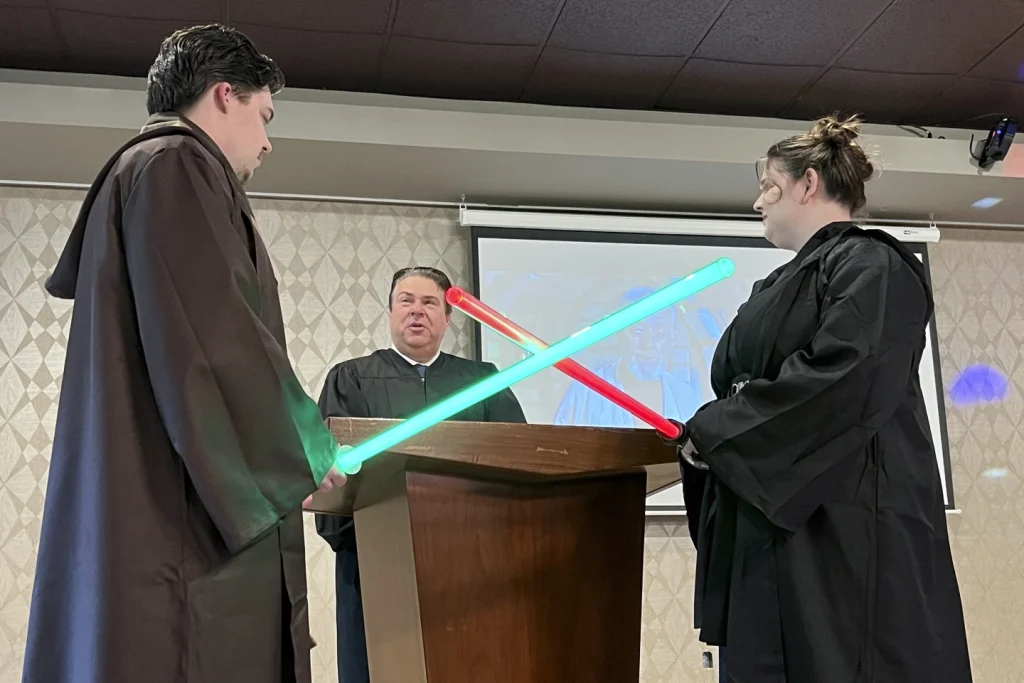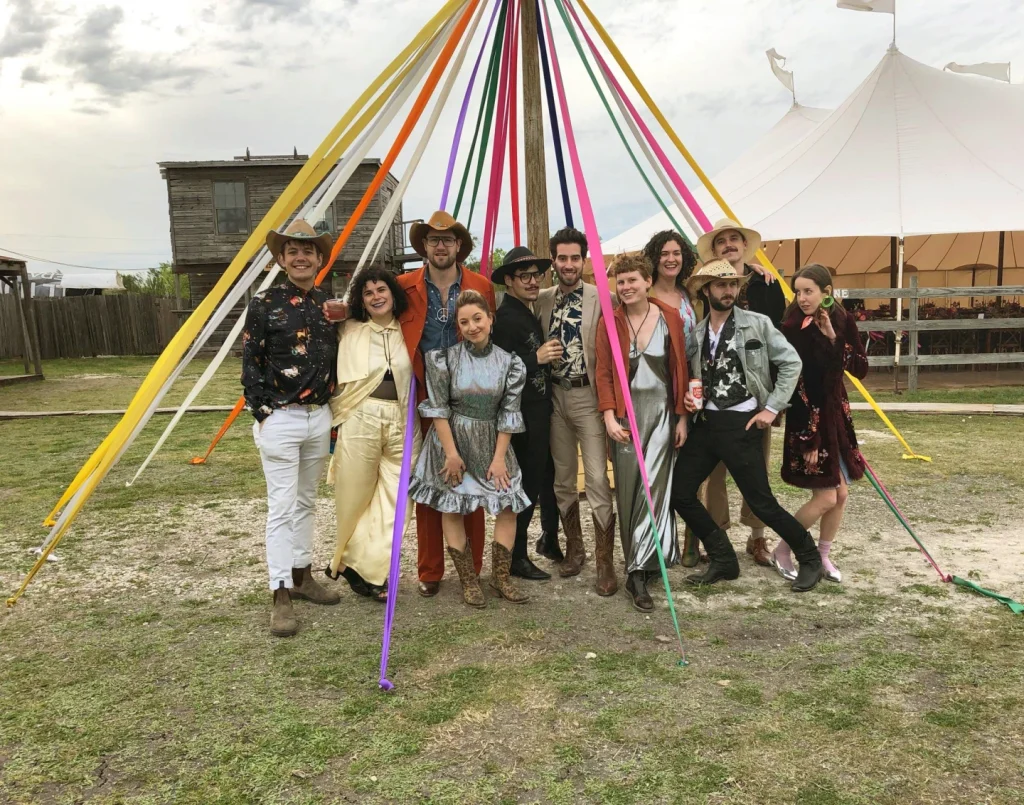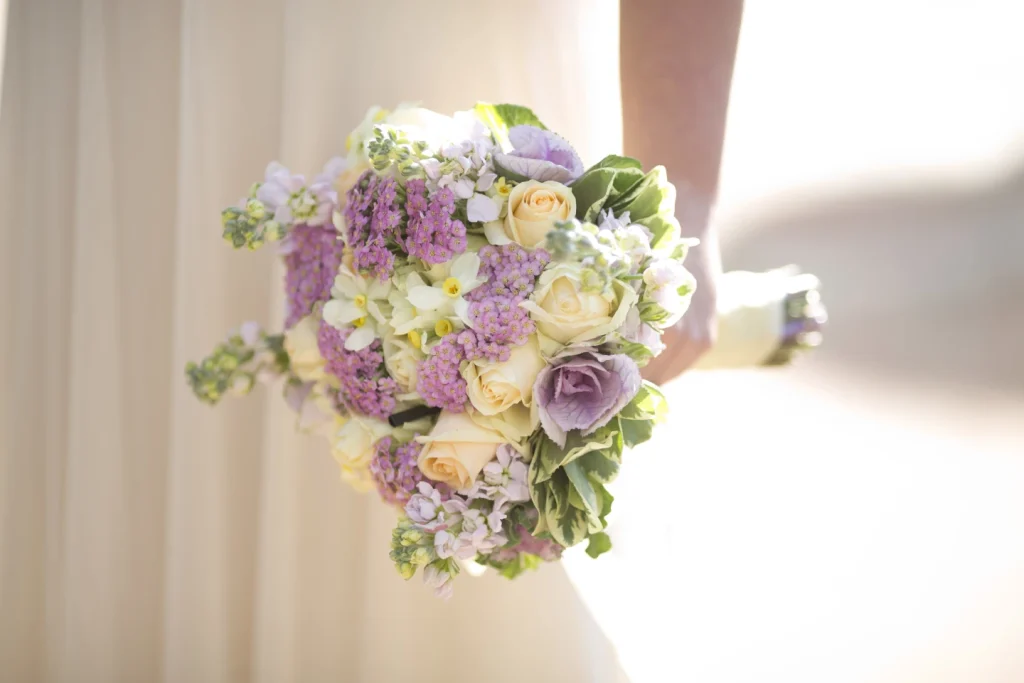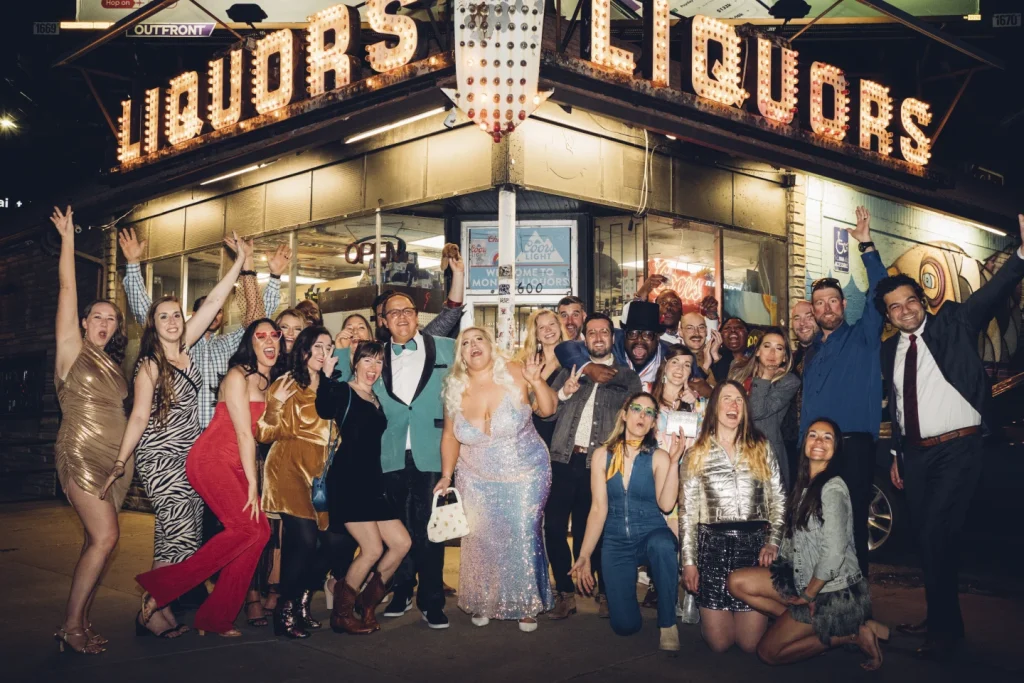Couples Embrace Unconventional Wedding Themes, Leaving Guests Confused About Dress Codes
Alternative wedding themes such as “Space Disco Cowboy”, “Yacht Shabbat”, and “Burning Man Formal” are becoming increasingly popular, shattering traditional dress code norms.
While some guests are left scratching their heads, couples are relishing the opportunity to create unique and fun atmospheres for their special day.
Maggie Long, a New York resident, experienced this firsthand when she attended a friend’s wedding in Denver, where the suggested dress code was “Dive Bar Semiformal.”
Long admitted that while she appreciates the creativity behind such themes, she found it challenging to decipher exactly what was expected of guests.
After engaging in thoughtful discussions with the officiant, who also happened to be a close friend, Maggie Long spent months exchanging ideas for her outfit at the wedding.
However, when she presented her initial choice of a strappy ultra-mini dress, the bride deemed it too reminiscent of “Kardashian cosplay.”

Long eventually settled on a slinky gold lamé dress by Norma Kamali. On the day of the wedding, a diverse range of outfits could be seen among the guests.
Vintage jumpsuits were a popular choice, and one attendee fully embraced the 1960s aesthetic with go-go boots and a bouffant hairstyle. Sequins were also a common sight.
To help guide guests, particularly older individuals, some couples are providing mood boards to illustrate the desired theme.
At the dive bar wedding, Long observed that even older guests enthusiastically participated and embraced the spirit of the occasion. For instance, one guest sported a rainbow tie-dye T-shirt in homage to the Grateful Dead.
As the summer wedding season approaches, guests like Indya Wright, based in Washington, D.C., are finding themselves faced with perplexing dress codes such as “Tropical Formal,” “Snappy Casual,” and “Garden Party Whimsical.” Exasperated, Wright took to Twitter to express her frustration with the new-age dress codes, yearning for the simplicity of traditional dress codes like “casual,” “cocktail,” and “formal.”
She humorously remarked that she now has to resort to Googling elaborate dress codes like “After 5 Formal Festive Renaissance attire” to decipher whether the event calls for a Great Gatsby or King Arthur & the Knights of the Round Table-inspired outfit.
Indya Wright, who is 35 years old, continues to feel frustrated with the evolving dress codes. She recalls attending a wedding of a college classmate where the dress code was described as “smart, but not too smart casual.” This ambiguous dress code left her uncertain about the appropriate attire for the occasion.

If you are seeking guidance on more traditional dress codes, here are some tips from “Emily Post’s Etiquette” centennial edition:
- Differentiate between “black tie” and “black tie creative/festive”: The former entails wearing a black or midnight navy tuxedo jacket and trousers or a floor-length, understated gown. The latter allows for more color in accessories like cummerbunds and permits statement jewelry.
- Understand the distinction between “casual” and “dressy casual”: Casual attire can include jeans, shorts, T-shirts, tank tops, and hoodies. It can also involve dresses and skirts paired with any top. Dressy casual calls for jeans worn with sweaters or casual buttoned shirts, or casual pants with dressier tops.
- Semiformal dress codes typically involve suits and ties or jackets and slacks for men, while women can opt for casual long dresses or cocktail dresses that are either at or below the knee.
Remember, traditional dress codes are typically more defined and follow established norms. However, it’s always a good idea to check with the hosts or wedding party if you have any specific questions or need clarification on the dress code.
Renée Strauss, CEO of Wedaways in Beverly Hills, California, believes that couples are embracing wacky dress codes to make their weddings unique. Communication is key to avoid confusion.
When creating wedding websites for clients, Wedaways includes dress code descriptions like “Wine Country Chic” to provide guests with guidance.
For example, “Tropical Formal” could involve bright summer colors and linen suits with playful ties. According to Strauss, guests have a lot of fun with these unique dress codes.
Rikki Gotthelf, a 32-year-old in Los Angeles, recently attended a unique wedding with the dress code “Space Disco Cowboy.” The event took place in an abandoned ghost town near Austin, Texas. Gotthelf and the other guests wore shiny intergalactic Batsheva prairie dresses. Another wedding she attended had a “Funky Formal” dress code.
To navigate these unconventional dress codes, Gotthelf sought advice from stylist Sophie Strauss. She suggests reaching out to the couple for clarification if the dress code is unclear.
Strauss explains that couples who create these unique dress codes are invested in how their guests look and would appreciate the effort to adhere to the theme.
For instance, one of her clients is attending a “Music Festival Formal” wedding but clarified with the couple that it should be more like Woodstock than Burning Man.
Having clear communication with the couple ensures that guests understand and can meet the dress code expectations for a memorable and enjoyable wedding experience.
According to stylist Sophie Strauss, the difference between a “Music Festival Formal” dress code leaning towards Woodstock compared to Burning Man is as follows. For the Woodstock-inspired dress code, guests can opt for hippie flowy dresses, bell bottoms, tunics, tie-dye patterns, big round sunglasses, and woven headbands.
On the other hand, a Burning Man-inspired dress code would involve a “Mad Max-meets-Carnival on mushrooms” aesthetic, characterized by lamé fabrics, combat boots, rhinestones, body paint, and goggles.
In this case, the client Strauss is assisting with the “Music Festival Formal” wedding has chosen a neutral-tone linen suit as well as a vintage beaded necklace or two for their outfit, aligning more with the Woodstock-inspired style.

To adhere to the “Music Festival Formal” dress code, stylist Sophie Strauss suggests the following tips:
- Opt for fabrics like linens, flowy cottons, tunics, and loose-fitting styles.
- If you’re not comfortable wearing fringe or bell bottoms, incorporate color and pattern into your outfit to stay on-theme. For example, you can wear linen or khaki slacks paired with a tie-dye, psychedelic, or Shibori print shirt. If you prefer wearing a dress, choose a comfortable and familiar dress shape but in a color or print that nods to the theme.
- Accessorize with items like headbands, big round glasses, dangly earrings, layered necklaces, vintage leather belts, and a fringy shawl to complete the “Music Festival Formal” look.
By following these suggestions, you can confidently dress according to the unique dress code and embrace the theme of the wedding.
Stylist Sophie Strauss emphasizes that when facing out-there dress codes, it’s important to remember that it’s not a costume unless explicitly specified as a costume party. Instead, small adjustments can be made to align with the theme while maintaining a formal appearance.
For example, wearing a regular suit but swapping out a dress shirt for one in an on-theme pattern can be a simple adjustment.
James Berger, who attended a wedding with an expressive dress code, managed to incorporate the theme by wearing a bow tie with multicolored polka dots and a formal suit. He felt slightly out of place among the sea of vibrant colors but still made an effort to participate.
Strauss often faces similar challenges with her clients. She recalls a client who had to dress for a “Fancy Ranch” theme and initially considered buying a new outfit entirely.
However, Strauss suggests that adding cowboy boots to a sundress or swapping a traditional tie for a bolo tie can go a long way in fitting the theme.
For those who are particularly enthusiastic, adding a cowboy hat can also enhance the overall look. It is not necessary to dress exactly like a specific character, but if that is one’s personal style, it can be embraced and celebrated.
Often, wedding themes have sentimental meaning behind them. Madison Smith, a bride-to-be in May 2024, has chosen the theme “Black Tie Sunset Glam” for her wedding at the Bonnet Island Estate in Long Beach Island, New Jersey. This theme is in honor of her late grandfather, who loved sunsets.
Smith envisions her guests wearing sunset-colored gowns in shades of oranges, yellows, purples, blues, and pinks, along with fun accessories. The men are expected to wear tuxedos with bow ties and pocket squares in the same sunset-inspired colors.
To ensure her guests understand the dress code, Smith, who works for Pinterest, has been pinning inspiration and creating boards to provide them with ideas. Her bridal shower guests even have their own board to help them navigate the “LoveShackFancy” dress code.
According to Amy Shey Jacobs, the founder of Chandelier Events in New York, themes like “Festive Hudson Valley Chic” or “Tropical Hipster” may leave guests with more questions than traditional dress codes, as they are not accustomed to such unique themes.

Jove Meyer, owner and creative director of an event planning company in Brooklyn, has experience handling unique dress codes such as “Chic as F—k,” “Gay Garden Party,” “Black Tie Fabulous,” “Colorful Cocktail,” “Sparkle and Shine,” and “Red Carpet Ready.” While he appreciates fun and creative dress codes, he advises couples to provide a clear description or sentence to avoid any confusion or guessing.
Brittny Drye, editor in chief of Love Inc. magazine, encourages guests not to hesitate in asking the bridal couple for clarification if the dress code is puzzling.
While couples may not want to be overwhelmed with questions, they should be prepared to answer inquiries when asking their guests to follow nontraditional dress codes. Open communication can ensure that everyone is on the same page and can confidently dress according to the couple’s vision for the wedding.
